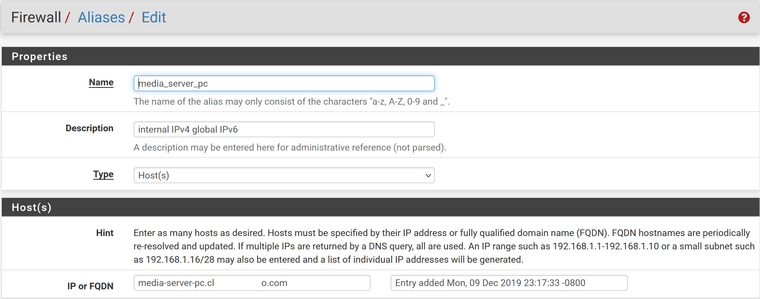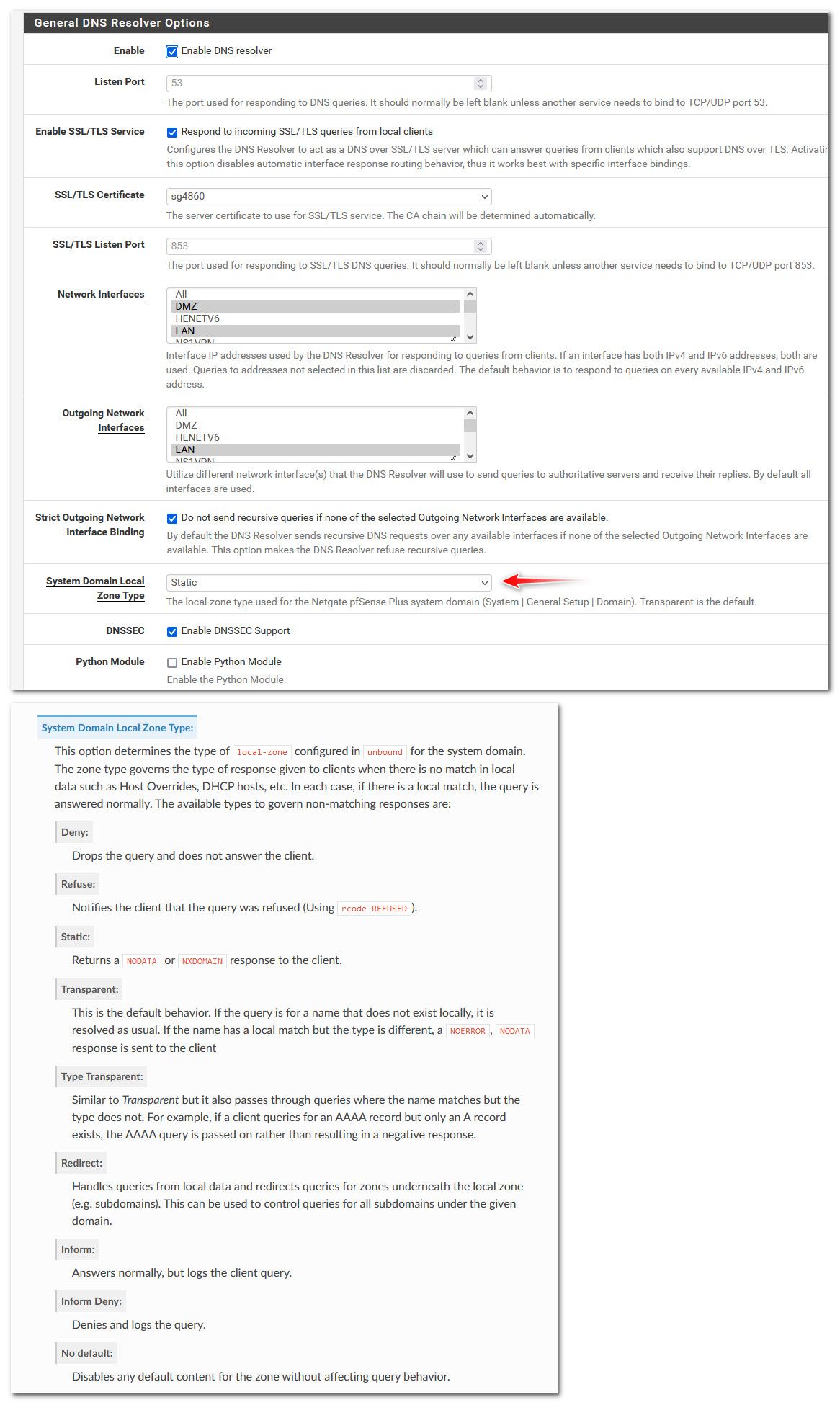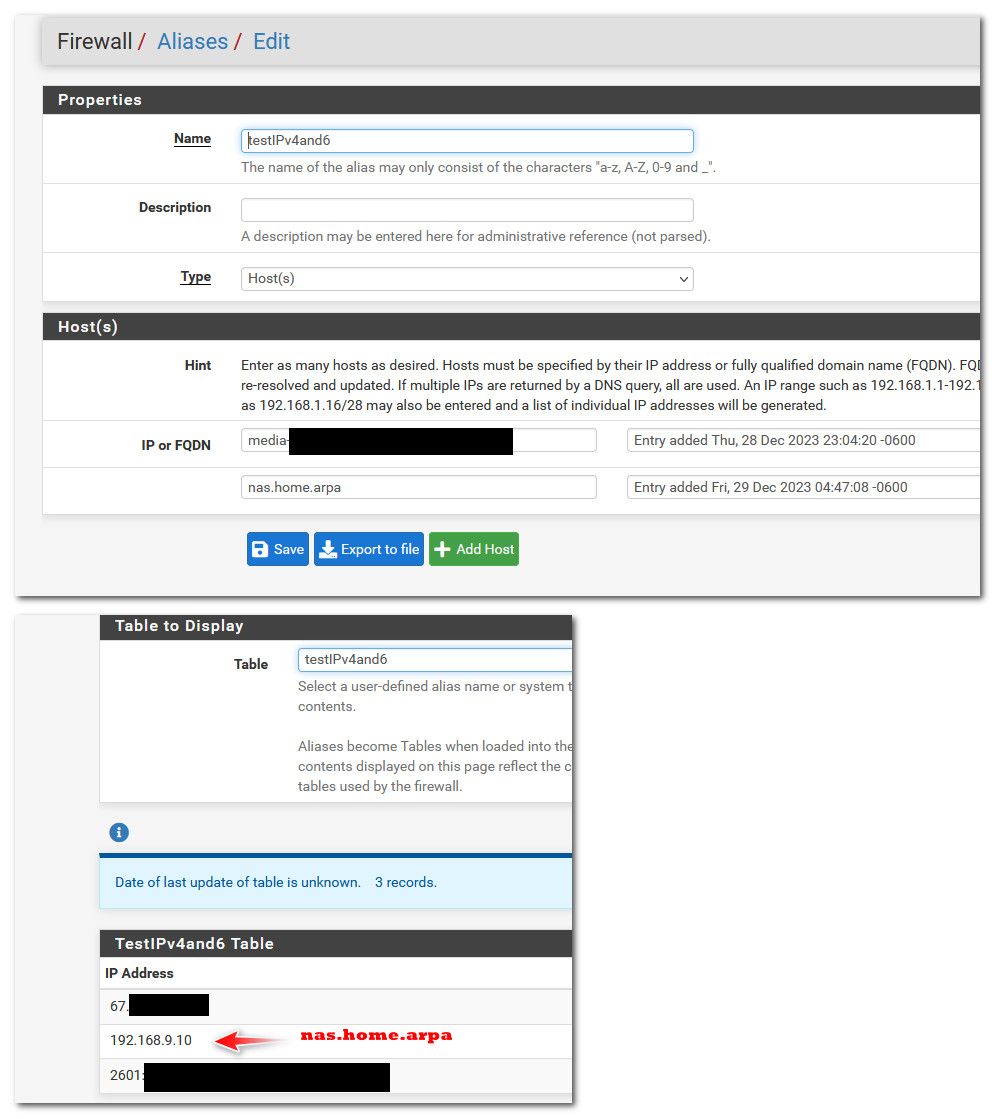Default deny rule IPv6 (1000000105) - it's happening again!
-
Re: Default deny rule IPv6 (1000000105) despite firewall rule
I'm having an oddly-familiar problem similar to the linked topic from 1-1/2 years ago. As I'm on the current version of pFsense, I didn't want to conflate the two incidents but the symptom is the same.
As a little history, I had version 2.7.0 working with firewall rules allowing an FTP server as well as Blue Iris security camera recorder on port 8083. I have other servers like a media server (Emby), home automation (Homeseer) and Ubiquiti Unifi controller on this same machine. Two weeks ago I had a pFsense upgrade accident relating to out-of-sync packages, so restored from USB stick to 2.7.2 using a recent 2.7.0 config.xml. This may have been when around the time the problem begun, although most everything else seems to work OK.
I have these servers IPv4 NAT'd with an auto-generated firewall rule. This rule is then edited to include IPv4+IPv6. FTP and Blue Iris on ports 21 and 8083 aren't working on IPv6, but can be reached via IPv4. Emby and Homeseer on ports 8096 and 8081 do work with the same firewall rules, probably on IPv4 from their Android app. I don't see rejection messages in the firewall log for IPv4 connections.
I'm configured with a relatively-static IPv4 and IPv6 cable internet with my server receiving a globally-routable IPv6 from my cable internet, pointed to by my FQDN. The WAN IPv4 address updates automatically using pFsense DDNS, I have to manually update my FQDN IPv6 once or twice a year. Currently ftp.myhost.com resolves to my external IPv4 and server IPv6. I see no problems with DNS functionality.
Connections from WAN IPv6 are being rejected (below), despite having NAT and firewall rules. Given it is IPv6 connections that are being rejected, NAT is not the problem. As the internet modernizes so many connections are made over IPv6, I really need it to work.


Below are the FTP and Blue Iris firewall rules, similar rules differing only by port number are used for every one of my 5 WAN-accessible servers pointed to by myhost.mydomain.com
In the rules below, I reference an alias media_server_pc pointing to my FQDN. How can I confirm this alias resolves to my external IPv4 and server globally-routable IPv6?



-
@lifespeed so you have your IPv6 address in a table - is this table populated with the correct address?
-
@johnpoz "table", sorry what does that mean? My server behind pFsense has an IPv6 address pointed to by my FQDN. IPv6 connections are being blocked in the router. Wouldn't it make sense to confirm the alias media_server_pc is getting the right IP addresses from my FQDN given the problem?
Edit: does "table" = "alias" ?
-
@lifespeed yes the alias puts it in a table - look under diagnostic tables
Yes that is exactly what I mean.. Check what is in the table via your alias to make sure it is correct.. Because if it was then it would be allowed per your rule so clearly its breaking down somewhere.. Either your fqdn is not resolving at all, and not being put into the table or its resolving to the wrong, thing, etc..
-
@johnpoz the bottom part of the diagnostics menu was cut off, had to zoom the browser out.
So I've got the internal LAN IPv4 address in Diagnostics/tables which is correct, but no IPv6. I know my FQDN resolves to the outside world, any idea where to look for the missing link in pfSense?
I just changed the alias from myhost.mydomain.com to mydomain.com. Both point to the same IPv6, but now the alias picked it up!
-
@lifespeed so when you lookup if your fqdn in dns lookup under diagnostics - it resolves or it does not?
-
@johnpoz when the alias referenced myhost.mydomain.com the alias only pointed to the LAN IPv4. When I referenced the alias to mydomain.com, tables then contained both IPv4 and IPv6, solving the problem. This doesn't seem right, because myhost.mydomain.com does resolve to the same, correct IPv6.
Edit: Ok, here is the rub with using an alias for both IPv4 and IPv6, I seem to get either just the LAN IPv4, which is correct for the NAT rule, or the WAN IPv4 and the server IPv6. But the WAN IPv4 isn't correct for an NAT rule to point to the server on the LAN.
-
@lifespeed said in Default deny rule IPv6 (1000000105) - it's happening again!:
because myhost.mydomain.com does resolve to the same, correct IPv6.
you mind sending me the fqdn in a private message and I can take a look to what could be causing the problem I could always put it into a rule on mine and see if it populates, etc.
-
@johnpoz done and thanks. I'm wondering why, with pfSense as my DNS server, mydomain.myhost.com doesn't resolve to the IPv4 LAN? It shouldn't go to external DNS for a host that has DHCP address reservation, right?
-
@lifespeed so that fqdn is resolving AAAA,
dhcp reservations should be a local query, but did you switch to kea, dhcp reservations for dns are not working in that as of yet
-
@johnpoz No, I knew not to switch to the new DHCP yet, I'll leave that up to the developers when they're ready.
-
@lifespeed let me change my unbound - I currently have it set to block all AAAA
-
@johnpoz I think I can't use the same alias and same firewall rules for IPv4 and IPv6 due to the behavior of grabbing the WAN IPv4 and global IPv6. I need the LAN IPv4 and global IPv6 to successfully use a common v4/6 alias and firewall rule. It seems I can get LAN IPv4 aliasing myhost to media_server_pc, and WAN IPv4 and global IPv6 aliasing to myhost.mydomain.com.
-
@lifespeed so I just created an ailas, put in your fqdn.. And my table shows both the public IPv4 and the IPv6.

Are you wanting the rule to resolve the fqdn to your local IPv4?
how do you have unbound setup for the zone... If your using the same domain public as local - you can run into some weirdness.
If you changed the zone type to static for example something in the same zone as your using local will not be looked up.. I am not sure what would happen if you had a local IPv4 but wanted to lookup a public IPv6 in the same alias?
-
@johnpoz exactly, it would seem for an alias to be useful in firewall and NAT rules, it should point to the LAN IPv4, as with IPv4 and NAT the WAN IPv4 doesn't point to a host on the network. Should a DNS inquiry, with pfSense as my DNS server, return the LAN IPv4? If I ping myhost.mydomain.com it answers back from my LAN IPv4.
I don't know what "zone" or "unbound" are, will look.
Was the desire for this alias behavior not thought of by pfSense, and the most-correct rule/alias fix is separate firewall rules and alias' for IPv4 and IPv6?
-
@lifespeed unbound is pfsense resolver.. (dns) as to zone type it defaults to transparent, I have mine set to static - because I sure don't need it asking the public ns if I typo some local host name that is in my local domain, which I have just recently moved to home.arpa vs local.lan

Personally I would never use the same domain locally as I am using public.. Use something else even if its your domainname with a .lan tld vs whatever your actual public tld is like .com.
It is quite easy to run into issues using a public domain that you have some records public, and some records local.. Especially if your hosting something local and would like to make sure your local stuff resolves the local IP vs the public IP, etc.
The new recommended domain to use locally is home.arpa
https://www.rfc-editor.org/rfc/rfc8375.html
Special-Use Domain 'home.arpa.'New installs of pfsense now default to this domain.
-
@johnpoz have I made an error in naming my local domain the same as public? Not quite sure the implication of trying to correct this, and where to make the changes without borking my network. A backup config will be in order.
Will renaming my local network from the public mydomain.com to home.arpa fix the issue of using a single alias to myhost.mydomain.com that returns the unwanted WAN IPv4 and global IPv6, or will I still need to create duplicate firewall rules, IPv4 alias to myhost or myhost.home.arpa and IPv6 alias to mydomain.com.
Where in pfSense do I rename my LAN, is System/General Setup the only place? Are there ripple effects elsewhere in my network config?
-
I see I'm using DNS forwarder instead of DNS resolver, is this a problem?
-
So I switched to DNS resolver instead of DNS forwarder, static instead of transparent, per your example. Also changed my local network domain to home.arpa. None of these changes altered the awkward alias behavior.
I now have separate alias and firewall rules for my server for IPv4 LAN address and IPv6 global address. It fixed my connectivity issues, but I must say this seems inelegant. I can't see how my use case is unusual, having some servers running behind pfSense that should be accessible from the WAN both IPv4 and v6.
-
@lifespeed Still not sure understanding your problem.. The alias resolves both your public IPs
But in a port forward rule where your forwarding via a nat you would want your local IP to be allowed in the rule.. not your public.. So that would be problematic.
Creating a nat and associating a firewall rule with the local IPv4, and then changing it to IPv4 and 6 that you want to resolve seems overall inelegant if you ask me.. Create your port forward rule for your IPv4 and its firewall rule. And then create a rule to allow your IPv6 using a fqdn if you want this is cleaner way to do it. There is no nat involved with the IPv6 putting it in the same rule that is used for nat is not a optimal setup imho.
A NAT firewall rule would be pointing to the local rfc1918 address, not your public IPv4 wan address.
But if you put in the local fqdn for your local resource, ie host.home.arpa that resolves to your local IPv4 that your natting too, that should work. Here I changed my alias to have both your public fqdn, and a local record for something I might forward too.

To be honest mixing IPv4 and 6 in the same table (alias) could be problematic as well because both your wan and your gua. If I was wanting to do something like that, I would create a fqdn that only has the AAAA record, maybe use something like host.ipv6.yourdomain.com and then your local fqdn for your rfc1918 you want in your nat.